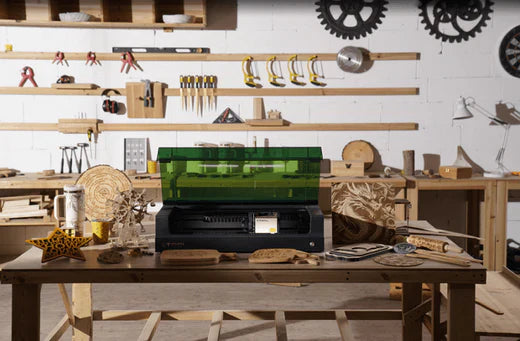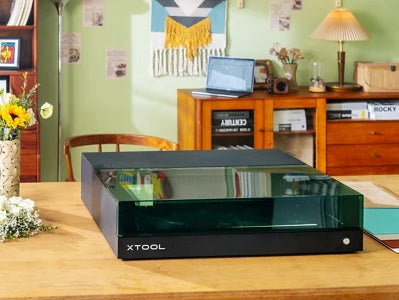Fiber vs. CO2 vs. Diode Laser: The Ultimate Guide
Laser engravers and cutters are commonly used and available nowadays. Many people use them to create all kinds of crafts and projects, to make homes sweeter, use them as gifts for friends and family, or sell them online to have an extra income.

Among all these laser machines, fiber lasers, CO2 lasers, and diode lasers are the three types used by most people.
But if you get confused about the differences between them, and which laser is perfect for your laser engraving or cutting business or project ideas, you are not alone.
All these types of laser engravers have distinct characteristics, pros, and cons, and they are used for different purposes.
In This Article
- What Is a Diode Laser Engraver and How Does it Work?
- What Is a CO2 Laser Engraver and How Does it Work?
- What is a Fiber Laser Engraver and How Does it Work?
- Diode Laser vs CO2 Laser vs Fiber Laser: Which Laser to Choose?
- Conclusion
What Is a Diode Laser Engraver and How Does it Work?
Diode laser machines are pretty popular on the market because they are available at a very reasonable price and are ideal for starting a small business.
A diode is a semiconductor that is made by combining p-type and n-type material. One side of the diode is p-type, and the other side is n-type.
The p-type and n-type materials are joined together, and the junction is called a p-n junction. Laser beams are emitted from this junction.
After applying the potential difference at the ends of the diode, electrons from the n-type travel towards the p-type, and the holes in the p-type travel towards the n-type, which works similar to LEDs, but the output is very intense and coherent, consisting of a single frequency.
Multiple laser diodes are used for high intensity, which is commonly called a diode bank.

The beams coming from the diodes are deflected using mirrors and passed through a converging lens. They converge the laser beams into a very fine spot which produces intense heat. The material at which the laser beams fall vaporizes quickly.

What Is a CO2 Laser Engraver and How Does it Work?
Named after the gas used inside the discharge tube, CO2 laser engravers were the earliest gas lasers that were invented in 1964. They have now become one of the most common types of laser engravers on the market and are widely used by small businesses.
In a CO2 laser, a discharge tube is filled with numerous gasses (also known as gas-filled tube), but CO2 is in the highest proportion, which is why the laser is called the CO2 laser. The other gasses inside the discharge tube are hydrogen, helium, oxygen, nitrogen, and xenon.

There are two electrodes at the ends of the discharge tube. When a high voltage is applied to the electrodes, the nitrogen molecules are excited. In the excited state, the molecules are in a metastable vibrational state.
These molecules excite the CO2 molecules present in the discharge tube. Now, when the excited CO2 molecules come in contact with the helium molecules, intense energy is released in the form of light or photons. These photons are the laser beams that are used to cut and engrave materials.
The light or laser beams that come out of the tube are pretty powerful. They instantly increase the temperature of the object that comes in contact and vaporize the material in no time.
The light or laser beams that come out of the tube are pretty powerful. They instantly increase the temperature of the object that comes in contact and vaporize the material in no time.
What is a Fiber Laser Engraver and How Does it Work?
Fiber lasers are the most powerful and thus the most expensive of all types. These have revolutionized laser cutting and engraving. It is a very new technology compared to CO2 laser and diode laser.
Fiber lasers also use a bank of diodes to create laser beams. We have already explained how laser beams are created in a laser diode. The same thing happens here, but the laser beams are amplified, which ultimately increases the power of the laser.
The output power of fiber lasers is around 2,000-4,000 watts. Industrial fiber lasers are more powerful and have an output rating of more than 10,000 watts.
These lasers are different from simple diode lasers because they have an amplification system. The laser beams travel through fiberglass or fiber optic cables, which amplifie the laser beams due to the presence of rare earth metals.

The amplified laser beams are highly powerful. They are directed towards a converging lens. The final laser coming out from the converging lens is capable of cutting metals. Due to its high output power, it can quickly melt metals. They are much more powerful than CO2 and diode lasers.
Fiber lasers are not suitable for small businesses because they are very expensive. Mostly, they are used to cutting metals, engraving, and marking serial numbers and barcodes.
Surprisingly, these lasers have a long lifespan and last a lot longer than CO2 lasers. In addition, they do not require excessive maintenance.
Diode Laser vs CO2 Laser vs Fiber Laser: Which Laser to Choose?
1) Materials the Lasers Can Cut and Engrave
The decision to select a type of laser depends on the materials you want to engrave and cut and what the laser machine can do.
First of all, if a laser can cut certain materials, it can also engrave them. But if a laser is engraving certain materials, it is not necessary it will be able to cut them. For cutting, high power is needed compared to engraving.
a. Dioder Laser Engravers
If you want to start a small business, a diode laser is a suitable option as it can cut and engrave a wide range of materials we commonly use.
Diode laser machines can easily cut 5-8mm thick solid wood, 5-10mm thick plywood, 2-5mm thick acrylic, cardboard, paper, and leather. These are the common materials that almost all laser diode machines can cut according to their power.

The materials that can be engraved by diode laser machines are plywood, solid wood, acrylic, paper, leather, steel, glass, ceramics, and a few more materials.
| Engraving | Cutting |
|---|---|
| Solid wood | Solid Wood |
| Plywood | Plywood |
| Glass/Ceramics | Cardboard |
| Steel | Paper |
| Leather | Leather |
| Paper | Acrylic |
| Acrylic |
b. CO2 Laser Engravers
CO2 laser machines are better than diode laser machines in terms of cutting materials. They can cut and engrave a broader range of materials.
A CO2 laser can cut wood, acrylic, foam, cardboard, leather, plastics, glass, fabric, rubber, paper, Corian, and MDF.
The materials that a CO2 laser can engrave are acrylic, wood, leather, plastic, fabric, glass, rubber, brick, ceramics, bone, aluminum, and steel.
| Engraving | Cutting |
|---|---|
| Solid wood | Solid Wood |
| Plywood | Plywood |
| Glass/Ceramics | Cardboard |
| Steel | Paper |
| Leather | Leather |
| Paper | Acrylic |
| Acrylic | Foam |
| Brick | Plastics |
| Rubber | Glass |
| Fabric | Fabric |
| Bone | Rubber |
| Aluminum |
c. Fiber Laser Engravers
Fiber laser machines can cut and engrave most metals and some non-metals. It cuts and marks metals that other laser machines cannot do. These machines are very powerful, so they can easily cut a wide range of metals.
But primarily, these lasers are used for marking and engraving. They can engrave aluminum, brass, copper, ceramics, tungsten, chrome, painted metal, fiberglass, carbon fiber, nickel, plastics, wood, rubber, silver, gold, stainless steel, and synthetic leather.
| Engraving | Cutting |
|---|---|
| Aluminum | Metal sheets |
| Brass | Leather |
| Copper | Wood |
| Ceramics | Acrylic |
| Tungsten | |
| Chrome | |
| Painted Metal | |
| Fiber glass | |
| Carbon fiber | |
| Nickel | |
| Plastics | |
| Leather | |
| Rubber | |
| Silver | |
| Gold | |
| Steel |
2) Laser Power
Beginners need to understand a few things while considering the power of a laser machine. There are three types of power ratings mentioned for laser machines. The three types are laser optical/output power, laser electric power, and machine power.
Machine power refers to the input power of the machines. It does not represent the power of a laser.
The second one is the laser electric power, which is the input electrical energy taken by the laser module. The power is related to the laser module, but it does not represent the ability of the laser to engrave and cut an object. However, it can be used to understand the electricity consumption of the laser module.
The most important power is the

The machine power rating is always the highest, and then comes the laser electrical power, and finally the laser optical power. For instance, a diode laser machine has an optical power of 10W, electric power of 40W, and machine power of 60W.
Beginners get confused between laser electrical power and optical power. Some companies also scam people by telling them the electrical power instead of optical power. Thus, you always need to see the optical power of the machine for comparison.
a. Diode Laser Engravers
Diode lasers have the lowest optical power compared to other types of lasers.
They are typically 5-15W. However, these can cut and engrave all materials we have discussed. Even this low power is suitable for small businesses. If the power is low, then there will be a few passes required.
xTool has introduced the world's first diode laser module with 20W optical power. The module is very powerful, which can cut up to 10mm plywood in one pass. It does the job quickly and with high precision. It increases the efficiency of engraving and cutting of a diode laser machine.
b. CO2 Laser Engravers
CO2 laser engravers are more powerful than diode lasers. They can cut more objects as the laser beams provide more heat energy.
The optical power of CO2 lasers ranges from 40W to 300W, making the machine are excellent for cutting and engraving more materials.
c. Fiber Laser Engravers
Fiber laser machines are ultimately powerful. They can cut metals, so you can assume how powerful they are. These laser machines typically have optical power of 2,000 to 4,000 watts, which is about 100 times the power of CO2 and diode lasers.
Industrial fiber laser machines are more powerful. The power rating could be more than 10,000 watts.
3) Lifespan
Lifespan is another critical thing to consider while buying laser machines. For instance, if the lifespan of a laser machine is less, then you need to buy replacement parts or a new machine. Consequently, it becomes expensive.
The lifespan of fiber lasers is the best. The expected lifespan is about 100,000 hours, which is commendable. But these machines are pretty expensive; the upfront cost is relatively high.
The diode lasers come next. They have an expected life of 25,000 to 50,000 hours. It is excellent for small businesses as it has an excellent lifespan and reasonable price.
The lifespan of CO2 lasers is the lowest, lasting for 5,000 to 8,000 hours. Therefore, you need to replace their parts often or replace the whole machine. In the end, it becomes a bit more expensive than diode lasers.
Simply put,
Lifespan: Fiber Lasers > Diode Lasers > CO2 Lasers
4) Speed
The speed of a laser is directly proportional to the optical power. The higher the power, the higher the speed.
Thus, we can say that fiber lasers have the highest speed as their power is 100 times more than CO2 lasers.
Then, there come CO2 lasers. They are slower than fiber lasers but faster than diode lasers.
Diode lasers come in the last, but it does not mean they take a lot of time. They are the slowest in comparison, but they can cut and engrave at a fast pace. They can cut an 8mm thick plywood at the speed of 1-3mm per second, which is quite fast.

5) Price
The final and most crucial factor is the price. If you want to start a laser engraving business at a low cost, there is nothing better than a diode laser machine. It is available at a very reasonable price, and the lifespan is excellent. So, it gives you an excellent ROI quickly.
Typically, diode lasers are available in the range of $700-$1500. For a business, you might need some extra attachments, such as rotary attachment and air assist.
CO2 lasers are in the middle. A typical CO2 laser will cost about $3,000 to $4,000. In addition, the lifespan of a CO2 laser is quite less, so you need to keep that in mind.
The most expensive laser on the market is a fiber laser. It is expensive as it is the newest of all and can cut metals as well as some non-metals. The price ranges from $15,000 to $20,000. The cost of an industrial fiber laser is a lot more than that. For small businesses, fiber lasers are a big no.
Conclusion
CO2, Fiber, and Diode lasers are different from each other in various aspects. The main difference is in their working principle. For a user, the difference is in the cost, materials they can cut/engrave, speed, lifespan, and power.
For small businesses, a diode laser is a perfect option. If you want to work on such non-metals that are not compatible with diode lasers, you can use a CO2 laser. The fiber laser is excellent in terms of cutting metals, but it is not suitable for small businesses.
Start a Laser Business




